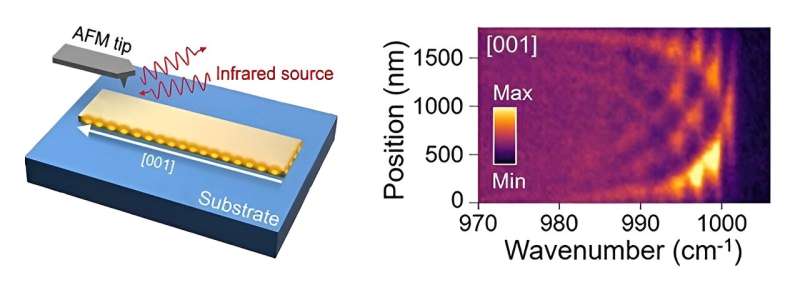The tip of an atomic force microscope (AFM) focuses infrared (IR) light from an X-ray beamline onto a tiny spot, enabling researchers to detect the lattice vibrations of an ultrathin, ribbon-like nanocrystal (yellow). Credit: Lawrence Berkeley National Laboratory and Stanford University
Combining electronics with infrared light can enable small, fast, and sensitive devices for sensing, imaging, and signaling at the molecular level. However, in the infrared spectrum, materials must meet strict quality requirements for their crystals in order to meet the requirements for these functions.
Now, researchers have found an improved way to make high-quality crystals that resonate strongly with infrared light. They tested these ribbon-shaped nanocrystals ("nanoribbons") using a unique infrared probe. The nanoribbons have the highest measured quality reported for such materials to date. This quality makes the crystals excellent prospects for use in high-performance infrared devices.
In their study, published in ACS Nano in 2022, the researchers made the nanoribbons using an approach called flame vapor deposition (FVD). FVD is fast, inexpensive, and scalable. It improves on a previous method that used adhesive tape to peel away material layers from a bulk material. FVD also doesn't require extra treatments that can damage and contaminate the crystals, which reduces their quality.
The nanoribbons produced using FVD have exceptionally smooth, parallel edges that function as reflecting surfaces. This enables the nanoribbons to naturally act as ideal resonating cavities for standing vibrational waves. The work allows for the direct, quick, and scalable production of high-quality infrared resonators for research and development.
Using FVD, researchers grew nanoribbons of molybdenum oxide (MoO3), a material that exhibits properties potentially useful for tuning its resonances to frequencies of infrared light. They controlled the sizes and shapes of the synthesized samples by varying temperature, molybdenum concentration, and time.
To measure the quality of these nanoresonators, the researchers used Synchrotron Infrared Nano-Spectroscopy (SINS) at the Advanced Light Source, a Department of Energy (DOE) Office of Science user facility at Lawrence Berkeley National Laboratory. SINS uses the tip of an atomic force microscope to focus beams of infrared light from the synchrotron radiation down to a spot size that's smaller than the wavelength of the infrared light.
The resulting resonance maps fully characterize for the first time the ultrabroadband infrared response of FVD-synthesized MoO3 nanoribbons with high spatial and spectral resolution, detecting resonance modes beyond the 10th order. The quality factors—a measure of the sharpness of the resonances—provide clear evidence of the high crystal quality of the synthesized nanoribbons.
More information: Shang-Jie Yu et al, Ultrahigh-Quality Infrared Polaritonic Resonators Based on Bottom-Up-Synthesized van der Waals Nanoribbons, ACS Nano (2022). DOI: 10.1021/acsnano.1c10489
Journal information: ACS Nano
Provided by US Department of Energy
























